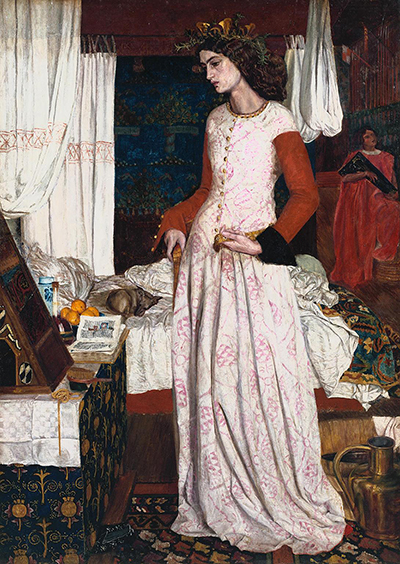La Belle Iseult (Queen Guenevere) is a particularly rare oil painting from the career of British artist, William Morris. He specialised much more in other mediums and disciplines such as textiles, furniture coverings and wallpaper design.
The painting found here will remind many of the work of the Pre-Raphaelites, and they surely influenced Morris within this piece. We find an attractive young woman staring at something within her bedroom. She is slim and pale skinned, which was entirely typical of the paintings produced within the Pre-Raphaelite movement, and the abundance of materials within this composition reminds us of Morris' main career focus. It seemed that even his move into oil painting could not exist without the same floral patterns appearing somewhere or other. Notice how she stands upon a decorative carpet, and also the table by her side is given a wallpaper finish. There are then further patterns upon her own clothing which is a full length dress that reaches up to her neck. Aside from this, the room itself looks somewhat untidy, as a maid appears from the background, ready to re-organise the room. Despite working rarely with oils, the artist attempts a challenging composition here which is entirely typical of his ambitious nature. The level of detail included here would normally only be seen by those who specialise in this medium, but Morris was always able to translate his ideas into new disciplines relatively quickly.
It must also be remembered that Morris would have spent considerable amounts of time in the company of others who specialised in oils and so would have inevitably picked up technical pointers at that time. His early grounding in artistic techniques, where illustration would normally be the initial focus, would also have given him a broad knowledge and understanding of both oil painting and watercolours. The painting itself in front of us here offers an insight into the artist's life, bringing up several interesting references to different events and important figures. For example, the model within this painting is, in fact, Jane Burden who became the artist's wife in 1859. The painting was completed a year earlier and is believed to have captured Queen Guenevere, with Morris writing poetry about the character in the very same year. That said, some reseachers have suggested that actually the content depicts Iseult mourning Tristram's exile from the court of King Mark. There remain many question marks around this piece, which has enjoyed an interesting journey since Morris first completed it over a century ago.
La Belle Iseult (Queen Guenevere) can be found in the collection of the Tate in the UK. This high profile institution is able to devote resources to discovering more about this piece, which may have contributed to new ideas about the content found here. They have several other items from his career which are on display in the Prints and Drawings Rooms, which can be accessed by the public with a prior appointment. In terms of seeing more of this artist's work, the V&A remains the best place to go within the UK, but the Tate's inclusion of La Belle Iseult (Queen Guenevere) offers a unique alternative, thanks to its use of oils. Those interested in adding some of his designs to their own homes will be delighted to find that several UK-based manufacturers offer reproductions of his work in a variety of forms, such as wallpaper, prints and even some handmade tapestries. La Belle Iseult (Queen Guenevere) itself remains his most famous oil painting and also reminds us of his connection to a number of famous British painters from the mid to late 19th century.




